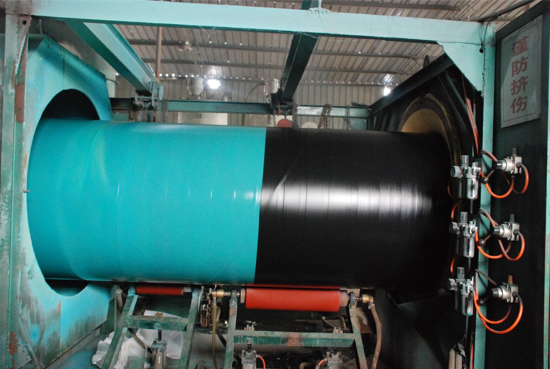Corrosion Prevention of Pipes (1)
Corrosion prevention of pipes refers to the measures to slow down or prevent the corrosion and deterioration of pipes under the chemical and electrochemical action of internal and external media or the metabolic activities of microorganisms.
Technical information
A technique to protect pipelines from corrosion by soil, air, and transport media (oil, natural gas, etc.).The pipeline conveying oil and gas is mostly in the complex soil environment, and the medium conveying is also corrosive, so the inner wall and outer wall of the pipeline may be corroded. Once the pipeline is corroded and perforated, it will cause oil and gas leakage, which will not only interrupt transportation, but also pollute the environment, and may even cause fire, causing harm. According to U.S. pipeline industry statistics, direct losses due to corrosion amounted to $600 million in 1975. Therefore, preventing pipeline corrosion is an important part of pipeline engineering.
Introduction to the Corrosion can be understood as a chemical reaction of materials in their environment, which can cause the loss of pipeline materials and lead to the failure of pipeline components or even the entire pipeline system. Corrosion in a pipeline system is defined as chemical reactions, electrochemical reactions, and microbial erosion in all metal and non-metal materials of the pipeline system, based on the particular pipeline environment, which can cause damage and loss to the pipeline structure and other materials. In addition to the direct damage to materials caused by corrosion, pipe damage caused by corrosion products can also be regarded as corrosion damage. Whether pipeline corrosion will spread or not depends on the erosivity of the corrosive medium and the corrosion resistance of existing pipeline materials. Temperature, the concentration of the corrosive medium, and stress state will affect the degree of pipeline corrosion.
Scope of application
This technical standard is suitable for civil and general industrial building equipment, pipeline corrosion prevention construction operations. Metal in the surrounding medium of chemical, electrochemical action is caused by a phenomenon of destruction. According to the corroded parts of the pipeline, it can be divided into inner wall corrosion and outer wall corrosion; According to the pipeline corrosion form, it can be divided into overall corrosion and local corrosion. According to the corrosion mechanism of pipelines, it can be divided into chemical corrosion and electrochemical corrosion.
The process flow: Base treatment → mixing paint → brush intermediate paintbrush or spray construction → maintenance
Pipeline anti-corrosion is divided into main body anti-corrosion and filler welding anticorrosion Pipeline anticorrosion chooses what material, according to the main pipeline anticorrosion layer material. There are petroleum asphalt filling, epoxy coal asphalt filling, viscose tape filling, powder epoxy filling, and PE heat shrinkable material filling, etc. If the main body of the pipeline is a three-layer PE composite structure, the three-layer PE heat-shrinkable filling material is preferred. Single-layer epoxy powder coating can be repaired by epoxy powder, adhesive tape + primer, and three layers of PE heat shrinkable repair.
The other: The most widely used steel pipeline anti-corrosion layer is petroleum asphalt, PE jacket and PE foam jacket, epoxy coal asphalt, coal tar enamel, epoxy powder and three-layer composite structure, epoxy coal asphalt cold winding belt (PF), rubber and plastic epoxy coal asphalt cold winding belt (RPC), etc. At present, the most widely used pipeline anti-corrosion methods are three-layer PE composite structure, single-layer powder epoxy, PF type cold tape, RPC type cold tape. Petroleum bitumen, a wide range of raw materials, low price. But working conditions are poor, quality is difficult to ensure, and environmental pollution is serious. Epoxy coal asphalt, easy to operate, but the coating curing time is long, affected by the environment, is not suitable for fieldwork, difficult to construct below 10℃.
Epoxy powder anticorrosion, an electrostatic spraying method, and the same material anti-corrosion tube body fusion, strong adhesion, but the epoxy powder water resistance is poor (high water absorption, up to 0.83%), to cathodic protection design brought some difficulties. The requirements of field equipment are high, the operation is difficult, and the quality is not easy to control.
3PE heat-shrinkable material, pipe anti-corrosion sealing, high mechanical strength, waterproof, stable quality, convenient construction, good applicability, no pollution to the environment.PE water absorption rate is low (less than 0.01%), at the same time with high epoxy strength, PE water absorption is a low and hot melt adhesive softness is good, has high corrosion reliability, the disadvantage is: compared with other filling material cost, the cost is high. PF type and RPC type cold winding tape construction is simple and easy, supporting three kinds of shaping glue so that PF type epoxy coal asphalt cold winding tape can be constructed in any environment, any season, any temperature conditions.
The characteristics of cold wound tape and 3PE heat shrinkable tape are: suitable for all kinds of material main anticorrosive coating pipelines, while other ways are suitable for the same or close to the material main anticorrosive coating pipelines. Secondly, with the development of some pipelines in anticorrosion at the same time also need to heat preservation, oil is a very complex mixture, easy to corrosion pipeline, anticorrosion is necessary, but the product pipeline in the case of anticorrosion also need to do heat preservation, in northeast and winter, thermal expansion and contraction will freeze crack pipeline, affecting stable supply.

https://www.lyhonten.com/Powder-coating-production-line.html

